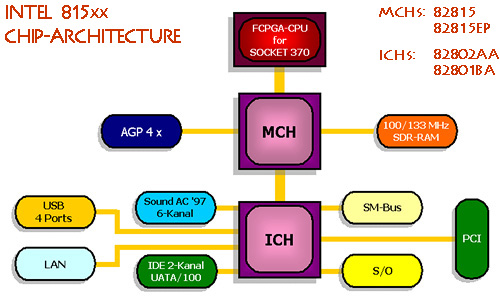|
|
| The chipset might be called the basic
element on a system board. It allows your PC to deal with the several
components installed in it i.e. harddisks, other drives, expansion cards
(VGA, Sound e.a.) and all the peripheric devices. Without that chipset
you would – metaphorically spoken- have a well-trained body with
a strong heart (the CPU) and worked-out muscles (the RAM), but you wouldn’t
have the brain functions to coordinate everything you would be capable
of doing. The part of the brain being occupied with such heavy stuff
is the chipset. It coordinates the connections between devices, operations
and orders and directs ‘movements’ where they ought to be
directed. |
|
| The chipset is responsible for the abilities
of the different buses so as PCI, AGP, IDE, serial, parallel and USB.
Basicly, the architecture of such chipsets is very similar. They consist
mostly of two elements, square-shaped chips called the Northbridge
and the Southbridge.
On the diagramm below you can easily find out what the two bridges are
responsible for. As an example I choose the very popular Intel 815xx
chipset that you can find on many modern socket 370-boards for Intel
Pentium FCPGA processors. |
|
|
The
popular Intel 815xx chipset exists in four different combinations,
being composed of one from two chips each. While the ICHs
differ in their DMA support (66 or 100) the MCH 82815 provides
integrated VGA. For further informations consult the chipset
comparison charts: |
|
ALi
Chipsets
AMD Chipsets
Intel Chipsets
SiS Chipsets
VIA Chipsets
|
|
| Intel changed the traditional working-way
of the chipsets a little, so they don't call the elements 'Northbridge'
and 'Southbridge' anymore. Instead of these terms they call them MCH
and ICH
- 'Memory Controller Hub'
and 'I/O Controller Hub'
whereby the MCH corresponds to the Northbridge and the ICH to the Southbridge.
Latest chipsets by Intel contain some more elements (hubs) responsible
for additional features. But in fact, the central architecture has always
remained the same... ;-) |
|
| The chipset market is dominated by four manufacturers:
ALi (Acer Laboratories), Intel, SiS and VIA. AMD also produces chipsets,
but they are only suitable to mainboards for their own Athlon and Duron
CPUs. On the other hand it must be clearly said that Intel doesn't build
chipsets for its competitor's (and rival's) processors, too ;-) ALi,
SiS and VIA manufacture chipsets for both universes, and from time to
time they can use one element (Southbridge) on both rails. And last
but not least: Don't be astonished whenever you find (on official websites
of board manufacturers!) chipset combinations that don't appear officially.
From time to time, webmasters can't differ '686B' from '696B', and the
reason of all evil is simply a mistake. On the other hand, some board
manufacturers seem to apply their 'own' combinations of North and South.
If such 'exotic mixtures' are provided by the chipset manufacturers
yet, is still a riddle to me. |
|
| SiS offers to us a speciality, the 'Single Chip-architecture'.
This highly integrated solution in fact is nothing else but a North-
and a Southbridge under one roof. Specially for low-cost systems this
might be a good solution: It allows a very small board layout and makes
additional components needless... if you don't expect too much from
them ;-) |
